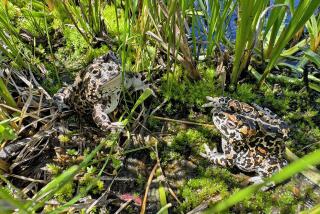Wild turkey
- Share via
[ MELEAGRIS GALLOPAVO ]
The only bird from the Western Hemisphere to reach global importance as a food source through domestication, the turkey is comfortable around people. Stalk one in the wild, however, and it’s a completely different creature. Wily and intelligent, wild turkeys flee when people approach in areas where they are hunted. In suburbia they are less suspicious and may openly gather in flocks of up to 200 birds as they forage for seeds and acorns. During winter, males and females live in separate groups, but by late January males begin gobbling and strutting to attract harems of females.
NATURAL HISTORY
Introduced to California from the southwestern and eastern United States in 1877, turkeys are found throughout the Sierra Nevada and scattered locations in the coastal ranges. Virtually nothing is known about their effects on native species.
KEY CHARACTERISTICS
This large, familiar bird shows many colorful iridescent feathers. In the breeding season, males develop a ridiculous looking “snood” that hangs like an inflamed appendix down their faces; they also have scraggly “beards” of thread-like feathers
poking from their chests.
More to Read
Sign up for The Wild
We’ll help you find the best places to hike, bike and run, as well as the perfect silent spots for meditation and yoga.
You may occasionally receive promotional content from the Los Angeles Times.






